Sienna Harvey | n12355119 | My development processes for assignments and workshop activities over my first semester of university in IGB120 (Introduction to Game Design)
Don't wanna be here? Send us removal request.
Text
Week 14: Shadowy Friend Development and Playtesting Report Postmortem
Overall, I am very happy about how Shadowy Friend turned out and the ways in which my group worked together to develop it. Because my previous prototypes were made individually, it was a new learning experience working with a group. This group showed me how understanding the various roles within game development is important. Doing this also allows each person to give advice and further insight to the right people, who are able to contribute to the very best of their abilities, if not the whole group (Fullerton, 2019). This is exactly why my team worked so well, as we put in place rough roles from the beginning, with each person working on an area they were confident in. Working with a group while playtesting also allowed us to gather significantly more information than I could ever do on my own.
In terms of the game itself, I learnt new skills in Gdevelop, especially working with different animations, how the shadow-player mechanics work, and how the player can interact with different objects. Working as a group and completing playtesting also provided heaps of insight on how the game could be improved, including things I personally would have never thought about.
When completing the report, I found it very interesting looking at and discussing the playtesting data. It highlighted how different players find different elements of a game more interesting than others, showing how everyone is different, which is why playtesting is so important.
This is the end of my blog, I am very happy with all of the skills I have learnt throughout this course and I hope you have enjoyed reading :)
References:
Fullerton, T. (2019). Game design workshop : a playcentric approach to creating innovative games. CRC Press / Taylor & Francis Group.
1 note
·
View note
Text
Week 13: Shadowy Friend Final Changes and Playtesting
This week, my group made some final changes to our prototype before conducting our final playtesting. This mainly included adding background music and sound affects as that was one of the main comments from previous play testers.
We play tested with 6 different people, primarily from our cohort. We first read our playtesting script which I talked about in an earlier post, then letting each player complete our game, providing limited assistance. I wrote notes on the events and actions of the player while my other teammates wrote down what the player was saying. Finally, we got each player to fill out a questionnaire about themselves and a survey about the game.
The players found bugs and glitches, as well as provided helpful feedback on how we could make it better. This primarily included the box mechanic, where the player would glitch when swapping characters in front of it.
Before and after swapping characters:
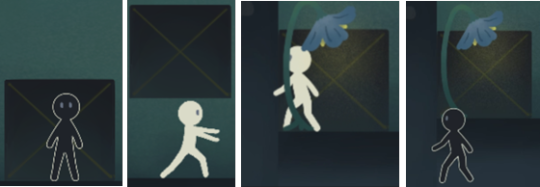
A few people also struggled to understand how the flower worked at first (it provides instructions on how to play).
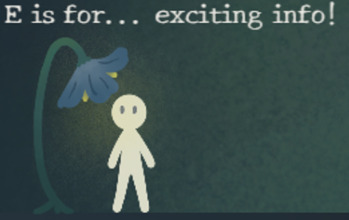
From here, we changed the original flower text be more obvious, clearly explaining that you must press ‘E’ to get instructions. We are also working on fixing the box mechanic as that was the main issue with our gameplay.
Overall, we will use this feedback in our prototyping and playtesting report which my group will complete as a part of our final assessment for this subject.
0 notes
Text
Week 12: Shadowy Friend Iteration and Changes
Within the past week, my group has developed 5 levels. When doing so, I created some new animations for pushing boxes and jumping, as we were not completely happy with previous ones I made.
Push animation:

Jump animation:

When designing the levels, we made sure to only include simple elements which require the basic mechanics in the first couple of levels, so the player could understand the rules and overall goals of the game. After the first couple of levels, which includes a tutorial level, we introduced some new items which required new mechanics and skills. This adds interest through complexity, as the player will now have to think harder when it comes to how they will complete the level. Well, that is what our main goal is at least.
To test these goals, I play tested with a few friends and some family to gain further insight before our final playtesting with our ‘complete’ game. While some of these people don’t usually play videogames, they still provided good feedback on elements which would have otherwise been missed by my group and I. One of the main points that stood out to me was the lack of sound affects (which we haven’t added yet), along with some platforms being impossible to jump between. We have since adjusted these platforms and are planning on adding background music and sound affects soon.
0 notes
Text
Week 11: Shadowy Friend Development
This week, our group didn’t get as much done as expected, meaning we weren’t able to playtest in our workshop. Instead, we focused on creating one level to showcase some finalised core mechanics which will be used throughout the game. We also planned out how we wanted each level to be laid out, including what mechanics and designs we wanted to use throughout.
A couple of us also worked on playtesting materials, including a playtesting script, survey, and a questionnaire. When creating these materials, we took into consideration what Tracy Fullerton says in her Game Design Workshop to accomplish the most useful playtest possible. The script includes an introduction to welcome the players and introduce our group and goals, and a warmup discussion to get to know the playtesters. We then explain an important part of the session; that we are testing the game rather than their skill, and the importance of the voicing any thoughts. We then plan to stay in the room, take notes, and watch quietly while the playtesters play out game for about 20 minutes. After this play session, we will discuss the players experiences using our questionnaire and wrap it up by thanking the testers.
From here, we aim to fully complete at least levels 1 and 2 by next week so we can use these materials to successfully playtest with other games students during our workshop.
References: Fullerton, T. (2019). Game design workshop : a playcentric approach to creating innovative games. CRC Press / Taylor & Francis Group.
0 notes
Text
Week 10: Assignment 3 Development Progress
This week, I made a group with 3 other people from my IGB120 workshop. For Assignment 3, we will further develop one group members game, like the prototypes I have previously shown in my blog, and write a Playtesting and Prototyping Report based on our development process.
Through looking through each group members prototypes in the workshop, one specific prototype called Shadowy Friend caught most of the group’s attention, with all members agreeing to develop it further for Assignment 3. This was largely because of the unique mechanics and design. My group decided to make a couple of immediate changes to the prototype. For the majority, this included changing how certain mechanics worked to improve the player experience, by making certain elements less complicated and clearer on how they work. This will allow the player to enjoy the game more, rather than being confused on how the game actually works.
This one-page one-sheet gives a good idea of my groups goals on what we want the game to include by the end.
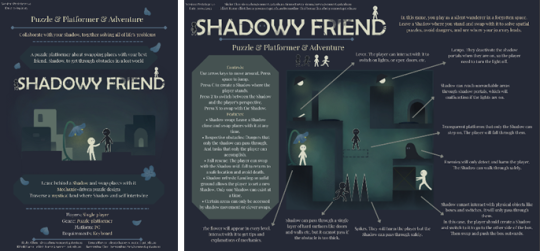
As a group, we also assigned some roles, so each person could use their skills to contribute equally. I will be focusing on the animation side, primarily designing the aesthetic elements, and how the player character looks when moving and interacting with certain elements.
Next week, I will post an update on how the development is going, hopefully including some playtesting insights.
0 notes
Text
Week 9: Racer Postmortem
Through my racing game development, I learnt the importance of having different levels of challenge throughout my game, as well as how to make a completely new style of game. Through playtesting, I realised some issues with my game, including cars spawning in strange positions after a long period of time, which I have fixed since. My play testers also commented on how they like the simplicity of my prototype, with the micro challenges and boosts occurring at rates which adds difficulty but doesn’t make the game feel impossible.
However, I would like to add different kinds of boosts/powerups to my game. For instance, some may let the player destroy other cars rather than dying to them. Instead of the player dying when they hit cones or oil spills, I would just make the player slow down or maybe lose some of their score to create some punishment without the player having to start over.
Overall, I am very happy with how my game has developed, especially because I have wanted to make a game like this from the beginning of my course. Next, I will begin IGB120 Assignment 3, where I will work in a group to further develop either one of my chosen game designs, or another group members designs. I have chosen to possibly elevate my platformer prototype, which will be focused off my one page and one sheet Assignment shown below.

Next week, I will begin a group assignment on another group members game, once again taking you through the development process.
0 notes
Text
Week 8: Racer Development
In this weeks IGB120 lecture, I learnt about challenge and rewards. What stood out to me the most was the importance of having different levels of challenges to complete the ultimate goal. This includes micro challenges, which takes up most of the players attention most of the time. For these kinds of challenges, players should receive instant feedback.
In Rush Racing, these micro challenges included dodging other cars and smaller objects like oil spills and traffic cones which spawn at random positions along the track to add some unpredictable challenge. Completing these micro challenges also adds to the players score which is a form of instant feedback to tell the player they are doing the right thing.

Intermediate challenges/goals are like small, less frequent, objectives to help them complete the ultimate goal. For Rush Racing, I added ‘golden’ arrows which don’t often spawn along the track. These arrows boost the players car, letting them pass obstacles quicker, adding to their score faster. This adds higher stress and more challenge for the reward, increasing the players interest and focus on the game.
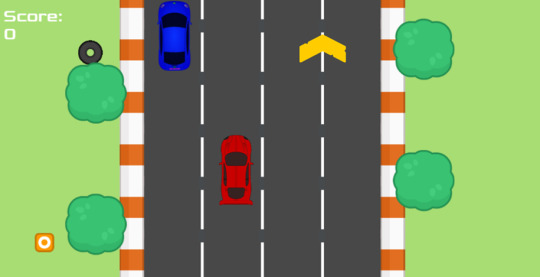
High level goals/challenges must be completed to reach the ultimate goal which, in this case, is to get the highest score possible. These challenges stay at the back of the players mind most of the game. So far, I have not included any of these, but I may add some larger objects/vehicles which are harder to get around as high-level challenges.
0 notes
Text
Week 7: Racing Elevator Pitch
Before I start creating my 'racing' prototype in GDevelop, I will make an elevator pitch to give both myself and others an idea of what my game will entail. The overall inspiration for my pitch is a typical racing game, with a few twists, as cars are an interest of mine.
Rush Racing
Pitch: Rush Speedway is the new hot spot for all car enthusiasts, and you have been invited to join ‘Rush Racing’. Rush Racing is hosting an event which puts racers in a high-stakes, action packed environment, where you must dodge obstacles without running off the tracks. This event can only have one winner, and the only way to be crowned is if you can drive the longest.
Controls: Left and right arrow keys to turn
Unique selling points:
The game gets harder the longer you live.
Instead of racing other competitors, you are aiming to stay on the track as long as possible.
Simple controls allow anyone to play easily, giving everyone the ability to enjoy it.
Concept art: I will use this as some inspiration for the aesthetics of my game.

References:
christiannastasestore. (2022). Premium PSD | Race car on transparent background. 3d rendering - illustration. Freepik. https://www.freepik.com/premium-psd/race-car-transparent-background-3d-rendering-illustration_34210132.htm?sign-up=google
rini astiyah. (2025). Formula Racing Sport Car Reach on Race Circuit the Finish Line Cartoon Illustration to Win the Championship in Flat Style Design. Vecteezy. https://www.vecteezy.com/vector-art/9668385-formula-racing-sport-car-reach-on-race-circuit-the-finish-line-cartoon-illustration-to-win-the-championship-in-flat-style-design
Luciadutkova84. (2020, July 22). Cartoon race track. Top view. Dreamstime. https://www.dreamstime.com/cartoon-race-track-top-view-curves-finish-line-flat-design-image191145231
0 notes
Text
Week 7: 'Asteroids' Postmortem
Through developing my asteroids-style prototype, I learnt a range of new skills both in Gdevelop and the overall design process. Earlier this week, I read chapter 10 of Tracy Fullerton’s Game Design Workshop textbook, where she focused on the process of coming up with ideas and turning them into an actual game. When brainstorming ideas, I made some basic lists of different ideas I had and turned them into mind maps, which helped to bring different elements of different ideas together. I originally chose a different idea for my game, however through editing and refining, I realised certain ideas were not technically possible to create in Gdevelop, and some I just did not like enough. Ultimately, I decided on my under-water themed game as it was the idea that I found the most interesting and could be refined in many different ways through my development process.
I am overall quite happy with how I translated my ideas into a prototype, with many of my play testers agreeing that it was very ‘fun’ to play. However, there are some ways I believe my game could be improved. A main element I would add to my game is some kind of powerups. For example, making you shoot/move faster, becoming invincible or adding affects to the player character. This would create some more interest to the game as the player would have more decisions to make.
Next up, I will be creating a racing game. My next post will showcase my elevator pitch.
References: Fullerton, T. (2019). Game design workshop : a playcentric approach to creating innovative games. CRC Press / Taylor & Francis Group.
0 notes
Text
Week 6: 'Asteroids' Development
This weeks IGB120 workshop focused on rules, decisions and affect. Something that stood out to me was the importance of making sure each decision feels unique; how the specific circumstances of each match should feel unique. This allows the player to make unique decisions in every instance. I thought this directly related to my Ocean Assassin game as each time it is played, it will be more engaging if enemies come from different places rather that one point, which is exactly what I did.
Game 1: Game 2: Game 3:

I also decided to add a pop-up text at the beginning of the game to point out the main rules of the game; explaining how it works to the player. This creates some certainty, allowing the player to make informed decisions, most of which, have an immediate impact.
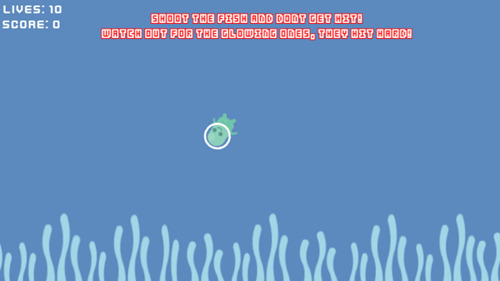
I chose to have certain fish (enemies) damage the player more than others, shown by the red ‘glow’ around them to add some more depth and interest.
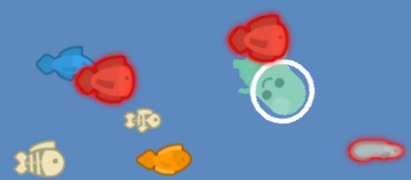
Some feedback I got from playtesting my platformer prototype was adding some sound to help evoke emotion. Therefore, I added sound effects when the player shoots, takes damage and gains health. This also helps illustrate to the player the effect of their actions.
Through playtesting Ocean Assassin, one of the main suggestions I received was to add a way to regain health and add balance; so I added a starfish which spawns in and gives you additional health upon collision.
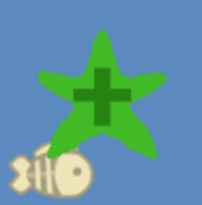
0 notes
Text
Week 5: Asteroids Elevator Pitch
In this weeks lecture, I looked further into the kinds of games I can make with GDevelop, including Asteroids-style games. Similar to my platformer prototype, I will begin my Asteroids-inspired game by creating an elevator pitch with concept art as follows; keeping in mind improvements I could have made on my previous prototype.
Pitch: Ocean Assassin is an action-packed asteroids inspired game, where you will be put under pressure to destroy your enemies. You, an unsuspecting diver, have been dropped in an ocean, bursting with all kinds of fish - fish that are trying to destroy you. They will attack from all angles, and you must fight back with your bubble blasts in order to stay alive.
Controls: Move mouse to change direction, left-click mouse to shoot.
Unique selling points: 1. A variety of vibrant sea creatures which have different damage/healing affects. 2. Includes colorful, bright aesthetics rather than more intense, violent feels as seen in a typical 'asteroids' game 3. Unique movement - looks as if you're swimming
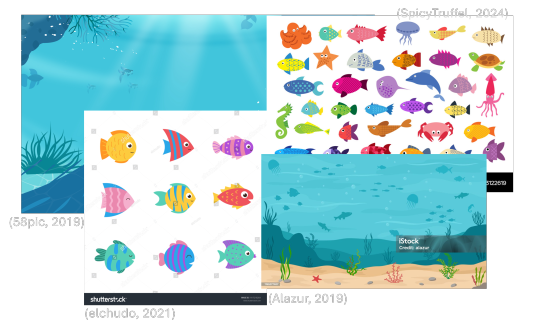
Next week, I will post my experience developing my "asteroids inspired" prototype.
References:
Alazur. “Sea Underwater Background. Marine Sea Bottom with Underwater Plants,...” IStock, 12 June 2019, www.istockphoto.com/vector/sea-underwater-background-marine-sea-bottom-with-underwater-plants-corals-and-fishs-gm1155277407-314461528.
58pic. “Cartoon Fresh Blue Underwater Diving Background, Cartoon, Blue, Diving Background Image and Wallpaper for Free Download.”
Pngtree, 2019, pngtree.com/freebackground/cartoon-fresh-blue-underwater-diving-background_932234.html.
SpicyTruffel. (2024, September 2). Cute fish set colorful different fishes starfish vector image on VectorStock. VectorStock. https://www.vectorstock.com/royalty-free-vector/cute-fish-set-colorful-different-fishes-starfish-vector-53122619
elchudo. (2021). Isolated Cute Sea Fish Set Freshwater Stock Vector (Royalty Free) 1917218264 | Shutterstock. Shutterstock. https://www.shutterstock.com/image-vector/isolated-cute-sea-fish-set-freshwater-1917218264
0 notes
Text
Week 5: Platformer Postmortem
Overall, I am quite happy how my platformer turned out. However, there are a few elements, both in the game and in my process, that I believe could be improved.
I feel I should have spent less time on aesthetics and instead used my time to change certain aspects I am not happy with. This includes adding more animated enemies, that the player could interact with and/or fight, to add some more excitement. Creating a more difficult path, which requires the player to use the jumping mechanic further, would involve additional concentration while still allowing the player to enjoy the experience and the movement my play testers enjoyed. Consequently, creating what Fullerton calls a “paradox of control”; a key element of the enjoyment of games which offers meaningful choices to players without providing complete control or assured outcomes.
I also believe my elevator pitch could have been more enticing by including a wider variety of concept art. This would have also helped to broaden my ideas and foster innovation, while allowing my audience to get a better understanding of the whole concept and the ideas I have in my head.
From here, I will be moving on to my next prototype "asteroids", and once again, posting updates on my process.
References: Fullerton, T. (2019). Game design workshop : a playcentric approach to creating innovative games. CRC Press / Taylor & Francis Group.
0 notes
Text
Week 4: Platformer Development: Playtesting
In chapter 1 of her Game Design Workshop, Fullerton explains that a key component to playcentric design early playtesting. This playcentric approach is crucial to help foster innovation. When I playtested with some classmates, one of the most common flaws was one of my obstacles, which was almost impossible to defeat, as there was no clear ways to bypass it. This made me realise that players will always experience the game differently to myself and I always have to keep their perspective in mind. Therefore, I added some text as a small hint to provide some guidance. The play testers also recommended that I should add some background noise to add more intensity to the game. While watching them play, I realised just some text explaining “you died” is very boring. Rather, the play testers agreed animated player deaths, along with sound effects, would be more engaging. However, all players liked the simple movement, using just a few keys, so they could focus more on what was happening on their screen.
Next, I will post an update on my overall thoughts on how my game turned out.
References: Fullerton, T. (2019). Game design workshop : a playcentric approach to creating innovative games. CRC Press / Taylor & Francis Group. Csikszentmihalyi, Mihaly. Flow: The Psychology of Optimal Experience. New York: Harper & Row Publishers, Inc., 1990. p. 49.
0 notes
Text
Week 4: Platformer Development: Creating my Prototype
When creating my platformer prototype, I made sure to keep in mind what Tracy Fullerton talks about in her Game Design Workshop, especially in chapters 1, 2, 3 and 8. In particular, when she explains a state of “flow”, where “an activity balances a person between challenge and ability, frustration and boredom, to produce an experience of achievement and happiness”. To help achieve this state, I made sure to include a few obstacles as a formal element of conflict to challenge players by forcing them to use skills that will cause them a sense of achievement when they overcome the challenges.
Obstacles: Creatures which when touched, eliminate the player.

I also had to continually remind myself that knowing when I am adding just enough visual elements vs when I am wasting valuable time is a crucial trick Fullerton talks about in chapter 8. Therefore, my prototype aesthetics might not be exactly what I would like in a finished version my game. However, in order to bring some of my ideas and my elevator pitch to life, I included some simple landscape elements including a ‘forbidden flower’ at the end of my game. As capturing this is the main objective, I made sure my player was aware of this from the beginning, using some simple text.
Start: End:

In my next blog, I will talk about my playtesting experience and what I learnt from it.
References: Fullerton, T. (2019). Game design workshop : a playcentric approach to creating innovative games. CRC Press / Taylor & Francis Group.
0 notes
Text
Week 2: Platformer Elevator Pitch
As an introduction to GDevelop, I will begin by making a platformer prototype. I will begin by making an elevator pitch which I learnt in this weeks lecture should hook people into playing my game. To put my pitch together, I will consider what Tracy Fullerton said in Chapter 1 of her Game Design Workshop textbook about “player experience goals”, which set the type of experience that players will have during the game. She says that “the sooner you can bring the player into the equation the better”, so considering what I would like them to experience from the start is crucial, and exactly what my pitch surrounds.
My platformer elevator pitch:
Mystic Mayhem takes you on an adventure through a mystical forest, where you will discover unprecedented creatures and must distinguish the difference between good and evil. You will be emersed in enchanted landscapes and vibrant, outer worldly flora. Through problem solving, you will explore your surroundings, with one mission – to find the forbidden flower.
Controls: Left/right arrow keys to move left or right. Shift key to jump
Unique selling points: 1. Challenges the player will have to overcome in unique ways. 2. A variety of interesting creatures - some enemies and some friends to help you along the way. 3. People of all ages will be able to play since there are simple controls, and not any challenges that are 'impossible' to complete.
After highlighting my player experience goals, I also need to consider aesthetics, styles and the visual elements of my game. To do so, I researched some concept art for my prototype:

From here, I will create my platformer prototype through experimentation in GDevelop and update you on my experience in my next post!
References:
Fullerton, T. (2019). Game design workshop : a playcentric approach to creating innovative games. CRC Press / Taylor & Francis Group.
Wonder Mural. (2025). Mural Wallpaper enchanted forest | Mystical landscape in shades of violet and blue. WonderMural. https://wondermural.com/products/mural-wallpaper-enchanted-forest-mystical-landscape-in-purple-and-blue-tones
Premium_art. (2025). Enchanted forest scene with glowing flowers and serene river at twilight. Stock Photo | Adobe Stock. Adobe Stock. https://stock.adobe.com/au/images/enchanted-forest-scene-with-glowing-flowers-and-serene-river-at-twilight/961742828
Naumov, E. (n.d.). Cartoon characters of mythical monsters. https://www.dreamstime.com/set-colorful-dragons-flat-style-cartoon-characters-mythical-monsters-vector-mobile-game-children-book-bright-colored-image121392711
Alina. (2012). Cute Cartoon Monsters. https://www.istockphoto.com/vector/cute-cartoon-monsters-gm165927494-21982385
0 notes
Text
Week 1: About Me
My name is Sienna, and I am a first-year student at QUT studying a Bachelor of Games and Interactive Environments. I am very creative and love drawing, painting and playing a variety of different games with friends.
My blog will showcase my development processes surrounding lectures and workshop activities over my first semester completing IGB120 (Introduction to Games Design) at university. By the end of the semester, I aim to have completed a variety of different game prototypes in Gdevelop; primarily learning how to make elevator pitches, the game itself and how to use playtesting effectively.
1 note
·
View note